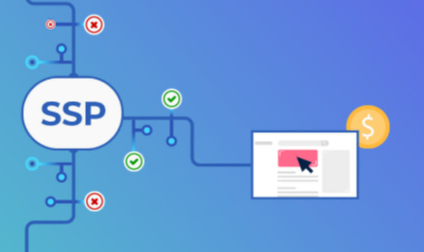Understanding SSP Advertising and How It Benefits Digital Publishers

In the ever-changing digital advertising landscape, Supply-Side Platforms (SSPs) have become essential tools for publishers looking to optimize their ad revenue. SSP advertising streamlines the process of managing and selling ad inventory, offering automation, efficiency, and better monetization opportunities. This article explores how SSPs work, their benefits for publishers, and strategies to maximize their potential.
How SSP Advertising Works
SSP advertising automates the process of selling digital ad space through real-time auctions. When a user visits a website or app, an ad request is sent to the SSP, which then:
- Communicates with multiple ad exchanges and Demand-Side Platforms (DSPs).
- Conducts a real-time auction where advertisers bid for the impression.
- Ensures the highest bidder wins, maximizing revenue for the publisher.
This process happens within milliseconds, ensuring that ads are delivered seamlessly without disrupting the user experience.
Maximizing Ad Inventory Value
One of the biggest advantages of SSPs is their ability to increase the value of a publisher’s ad inventory. Instead of selling ad space at fixed rates, SSPs use dynamic pricing, allowing ad prices to fluctuate based on demand. This means publishers can earn higher rates for impressions that attract competitive bids.
Additionally, SSPs aggregate inventory from multiple publishers, creating a large marketplace where advertisers compete for ad placements. This increased demand can lead to higher bids, especially for premium content with highly engaged audiences.
Efficiency and Automation
SSPs bring automation to digital advertising, eliminating the need for manual negotiations and direct sales. They manage:
- Ad serving – Ensuring ads are displayed in the right places.
- Targeting and audience segmentation – Helping advertisers reach the most relevant users.
- Auction mechanics – Running real-time bidding (RTB) auctions efficiently.
This automation reduces operational costs, speeds up ad delivery, and enhances user experience by preventing delays caused by slow-loading ads.
Read more: Cheryl Parsa Net Worth: $1 Million
Enhanced Targeting for Higher Revenue
With SSP advertising, publishers can provide advertisers with detailed audience insights, including:
- Demographics (age, gender, location, etc.).
- User behavior (browsing habits, interests, purchase intent).
- Contextual data (content type, page category).
This level of precision attracts higher bids from advertisers looking to target specific users, ultimately boosting publisher revenue.
Expanding Access to Advertisers
SSPs give publishers access to a global pool of advertisers, increasing demand for their inventory. Instead of relying solely on direct ad sales, publishers can:
- Reach international advertisers willing to pay premium rates for niche audiences.
- Sell ad space through multiple ad exchanges, increasing competition and maximizing yield.
- Work with both programmatic and direct buyers, diversifying revenue streams.
This broad marketplace ensures that even smaller publishers can monetize their content effectively.
Challenges in SSP Advertising
While SSPs offer many benefits, publishers must navigate certain challenges:
- Ad Quality Control – Without proper oversight, SSPs may serve low-quality or irrelevant ads that harm user experience. Publishers should set strict ad quality guidelines.
- Privacy and Compliance – With regulations like GDPR and CCPA, publishers must ensure their SSP partners comply with data protection laws.
- Ad Fraud Prevention – Fraudulent activities like bot-generated traffic can distort ad performance metrics. Using fraud detection tools is crucial.
Addressing these issues ensures publishers can fully capitalize on SSP advertising while maintaining user trust.
Best Practices for Maximizing SSP Revenue
To get the most out of SSP advertising, publishers should implement these strategies:
- Use Multiple SSPs – Connecting to more than one SSP increases competition for ad impressions, driving up bids. However, careful management is needed to avoid inefficiencies.
- Leverage First-Party Data – With third-party cookies phasing out, publishers should use their own audience data to enhance targeting and attract premium advertisers.
- Balance Ads with User Experience – Too many ads can disrupt site usability. Finding the right balance ensures high engagement while maximizing ad revenue.
- Monitor Performance Metrics – Tracking fill rates, eCPM, and viewability helps publishers refine their strategies for better results.
The Future of SSP Advertising
As technology evolves, SSPs will continue to adapt. Some emerging trends include:
- AI-Powered Optimization – Machine learning will improve bid predictions, ad placements, and personalization, increasing ad revenue.
- Privacy-Focused Advertising – With stricter data privacy laws, SSPs may shift toward contextual targeting, where ads are placed based on page content rather than user data.
- Programmatic Direct Deals – SSPs will facilitate more direct transactions between publishers and advertisers, ensuring better control over pricing and ad quality.
- Expansion into New Channels – SSPs are already extending into connected TV (CTV), in-game advertising, and digital out-of-home (DOOH), opening new monetization opportunities for publishers.
Leveraging SSPs for Long-Term Growth
For digital publishers, SSP advertising isn’t just about increasing immediate revenue—it’s about creating a sustainable monetization strategy. By understanding how SSPs work, optimizing their use, and staying ahead of industry trends, publishers can build a more profitable and resilient business model in the ever-evolving digital landscape.
